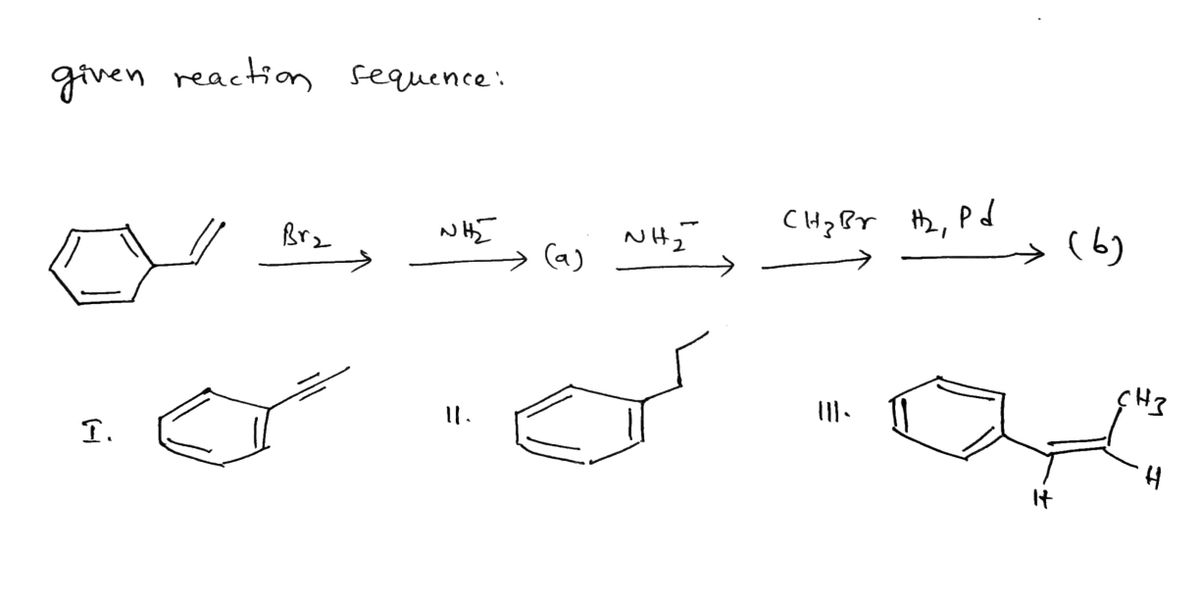Chemistry
10th Edition
ISBN:9781305957404
Author:Steven S. Zumdahl, Susan A. Zumdahl, Donald J. DeCoste
Publisher:Steven S. Zumdahl, Susan A. Zumdahl, Donald J. DeCoste
Chapter1: Chemical Foundations
Section: Chapter Questions
Problem 1RQ: Define and explain the differences between the following terms. a. law and theory b. theory and...
Related questions
Question
Give the product (b) of the synthesis shown.

Transcribed Image Text:**Transcription for Educational Website:**
### Chemical Reaction Sequence Diagram
This diagram illustrates a sequence of chemical reactions involving three compounds labeled as I, II, and III. Each step in the sequence involves specific reactants and conditions:
1. **From Compound I to II:**
- Reactant: \( \text{NH}_2^- \)
- The reaction proceeds as shown from I to II.
2. **From Compound II to III:**
- Reactant: \( \text{CH}_3\text{Br} \)
- The transformation involves adding a methyl group.
3. **From Compound III to Final Product:**
- Reactants: \(\text{H}_2\), \(\text{Pd}\)
- The presence of hydrogen and palladium facilitates the reaction towards the final product shown to the right of III.
### Multiple Choice Assignments:
- **A:** I
- **B:** II
- **C:** III
Each letter corresponds to the respective compound or step within the diagram. The arrows indicate the direction and order of reactions, with specific reagents driving each transformation.
This diagram showcases the methodical transformation from one organic compound to another, highlighting the roles of specific reagents and catalysts in the chemical process.
Expert Solution
Step 1

Step by step
Solved in 2 steps with 2 images

Knowledge Booster
Learn more about
Need a deep-dive on the concept behind this application? Look no further. Learn more about this topic, chemistry and related others by exploring similar questions and additional content below.Recommended textbooks for you

Chemistry
Chemistry
ISBN:
9781305957404
Author:
Steven S. Zumdahl, Susan A. Zumdahl, Donald J. DeCoste
Publisher:
Cengage Learning

Chemistry
Chemistry
ISBN:
9781259911156
Author:
Raymond Chang Dr., Jason Overby Professor
Publisher:
McGraw-Hill Education

Principles of Instrumental Analysis
Chemistry
ISBN:
9781305577213
Author:
Douglas A. Skoog, F. James Holler, Stanley R. Crouch
Publisher:
Cengage Learning

Chemistry
Chemistry
ISBN:
9781305957404
Author:
Steven S. Zumdahl, Susan A. Zumdahl, Donald J. DeCoste
Publisher:
Cengage Learning

Chemistry
Chemistry
ISBN:
9781259911156
Author:
Raymond Chang Dr., Jason Overby Professor
Publisher:
McGraw-Hill Education

Principles of Instrumental Analysis
Chemistry
ISBN:
9781305577213
Author:
Douglas A. Skoog, F. James Holler, Stanley R. Crouch
Publisher:
Cengage Learning

Organic Chemistry
Chemistry
ISBN:
9780078021558
Author:
Janice Gorzynski Smith Dr.
Publisher:
McGraw-Hill Education

Chemistry: Principles and Reactions
Chemistry
ISBN:
9781305079373
Author:
William L. Masterton, Cecile N. Hurley
Publisher:
Cengage Learning

Elementary Principles of Chemical Processes, Bind…
Chemistry
ISBN:
9781118431221
Author:
Richard M. Felder, Ronald W. Rousseau, Lisa G. Bullard
Publisher:
WILEY